Reader's Choice
Popular articles
Handwork is a value, because warmth, love and care of the craftswoman are put into the product. Associated rugs for children are good because they can serve even more than one generation and become a real relic. This is not just an ordinary decoration in a pram or crib, but a practical thing in the dowry of a newborn.
Knitting is the most common type of needlework. However, before starting the process, it is necessary to stock up with all necessary. Children's blanket with your own hands should begin with the selection of suitable yarn and knitting needles. It is better to take a thread with which it would be convenient to work. The yarn for a children's plaid can be very different, but the main thing is that it fits the tool. Knitting needles need labeling number 3, suitable for threads of normal thickness. You can use this material:
Children's plaid knitting can be connected in various ways, while creating spectacular patterns. There is a huge choice of schemes, but there are two main types: with front and purl. In this case, all the loops are knitted either for the front bow or for the back. The main knitting methods used by masters include:
Even a person who has never done handicrafts before will be able to make a duvet. Children's plaid knitting knits easily, because each of the options attached detailed scheme with step by step description. Take a tool for knitting and act. Having studied the schemes of different complexity, look for knitting a rug with knitting needles with a description for your level, then you will get the desired type of bedspread. For starters, pick models with simple patterns: these can be repetitive geometric patterns. All that is required of you in work is attentiveness.
Such a fluffy product - the best that can be for winter. You will not constantly worry about the fact that the child will freeze. Knit it very easily and quickly - we can say that this is a blanket for a newborn with needles for beginners. Use 100 m / 100 g of wool blend yarn and No. 15 knitting tools. There will be a product measuring ten meters by meter twenty. It is better garter stitch:

A charming multi-colored object made up of small squares with children's drawings looks particularly beautiful. It is easy to knit: alternately purse alternately, then facial loops. However, you can tie a blanket for a newborn with knitting needles of a more complex pattern: with braids of various motifs. The children's blanket consists of twenty squares with dimensions of 15.5x17.5 cm. The general parameters are equal to 85x60 cm. For work we select:
The product of this implementation is suitable for both girls and boys. You can knit a plaid for a newborn with needles with a delicate openwork pattern. Thing perfectly decorate the place of rest of the child, warm in the cold. For the manufacture will need white yarn and circular tools with the marking number 3, number 5. Step by step we make a beautiful soft covering:

Light plaid for a newborn knit knit in a pattern of "chess". White, pink or blue color is suitable for discharge of the child from the hospital. The alternation of facial loops with purl forms a pattern in the form of a chessboard. Double-sided pattern is also suitable for knitting scarves and hats. Blankets in this design are very practical, because they have no wrapping corners.
Before the knitting process itself, it is advisable to determine the parameters of the product, that is, to choose the size of the squares. Elements 4 by 4, 5 by 5 or 6 by 6 will look more harmonious. The scheme of a children's rug with knitting needles, for example, four by four, is simple. It consists in that four personal eyelets alternate with four purl and repetitions — a similar number of rows is knitted.
Prams are decorated with cozy bedspreads, because they not only decorate the transport, but also provide comfort for the child in the off-season and winter season. The cotton model will look great. AT the stroller will fit size meter per meter. For knitting used yarn from one hundred percent lightweight cotton. Take knitting needles with marking No. 4. Blanket is done beautiful pattern "Rice":
Before making a baby blanket, knit a small square sample measuring 10 by 10 cm to calculate the number of eyelets. So you will see a solid pattern, which then turn out to be finished product. The sequence of shades for strips choose your own. Experiment with a combination of colors in rows on the mini-sample to choose the right combination.
The most detailed scheme of the rug with knitting with hearts is ready. The children's plaid connected by front and back loops, perfectly will be suitable for the beginning knitters.
My reader was interested in a nice blanket with hearts in an article on the site, and she asked me to publish a pattern for knitting. Since it is difficult for beginners to cope with drawing schemes and knitting, I give schemes and a complete description of the work.
Patterns may be the most intricate, but they usually begin to learn from knitting facial and purl loops, and this is what we need.
I rashly decided that everything can be easily understood from the photo. I just forgot that at the beginning of any path, everyone is a beginner and it is equally difficult for everyone to master a new business.
I linked the sample, the motive of the heart, to figure out where to start, what size the product will turn out and, in general, check, so to speak, on myself. Here is a photo.
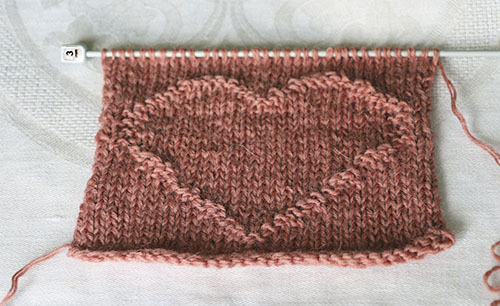
Important: Be sure to knit the patterns. it general rule Absolutely for all knitters of any level of readiness. Different yarns, different patterns and different hands sometimes give incredible deviations from the intended sizes. Be sure to wash the sample, dry and steam, (do not iron, do not press the iron, but only with steam, holding the iron on the weight to align the loops and give the knitting a good look) and then take measurements and count the number of loops per 1 cm of the product.
I did not close the sample sheet so that a needle could be seen, on which a fragment with a heart was knitted.
Notice that in the diagram all empty cells are facial. We look at the scheme as if we are holding a canvas in our hands. That is, all even rows are a wrong side of knitting, so in an even row we knit a wrong loop, and from the face it looks face loopand in the diagram it is shown on the front. This is called knit by pattern.

The edging is connected with a pearl pattern.
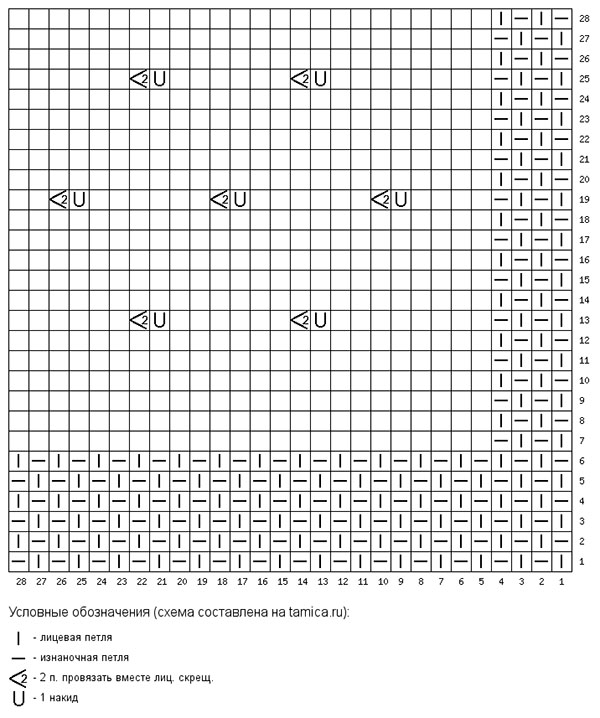
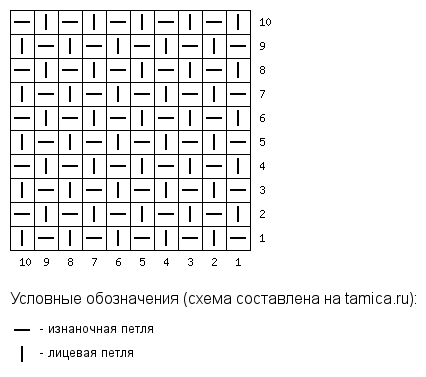
This pattern is called pearl or rice. It is very good for intermediate sections in complex patterns with braids, harnesses and knobs. It is knitted simply by alternating in a chessboard fashion of facial and purl.
![]()
How many loops to dial for the entire rug, let's count.
Plaid edged pearl viscous. Edging on the sides of 4 loops. In the middle of the canvas 3 hearts. Each heart is 29 p, between hearts by 8 p and from the edging at the edges also by 8 loops.
Total: 4p + 8p + 29p + 8p + 29p + 8p + 29p + 8p + 4p + 2 edge loops = 129 loops
After we knit the samples of a heart, a chess pattern, a fragment with holes (to see how the hole turns out as a result of knitting a nakida and two loops together), ten loops and ten rows of a corner, (practice the pearl pattern), washed, dried and steamed, We pretend what size pledik get.
If you want a large blanket on the sofa, with dimensions of 200 by 210 cm, increase the number of hearts, the size of hearts, the number and size of bands.
But it is this blanket for children, its width is 60-70 cm. Depending on the thickness of the yarn.
Information about the yarn of the original children's plaid with hearts:
100% acrylic, 288 meters, 170 grams - only 4 skeins. From them pink yarn take 2 skeins (340gr). White (natural tint) - 1 hank (170g) and light brown - 1 hank (170g). Source etsy.com/shop/DeborahOLearyPattern
Knit better with circular knitting needles, thickness 3 -5mm. On circular it is easier to hold a large canvas, but to knit, of course, not in a circle, but as with ordinary straight knitting so that the stocking does not turn out.
In some cases, the seamy side of the plaid is reinforced with a lining. This, as they say, how you like. Some kids like it and no lining. Read about this cute little girl below, this is a bonus.
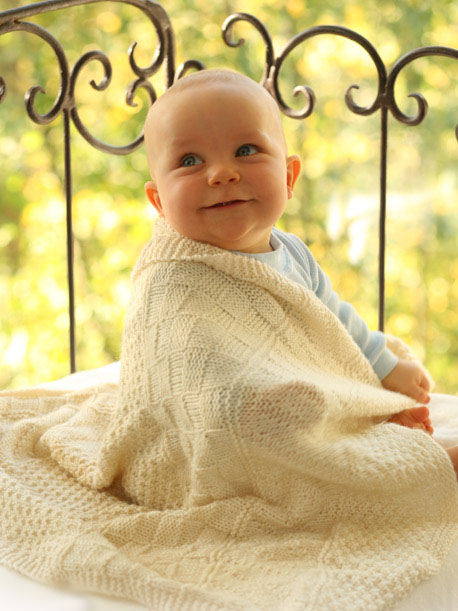
And if you choose the option on the lining,
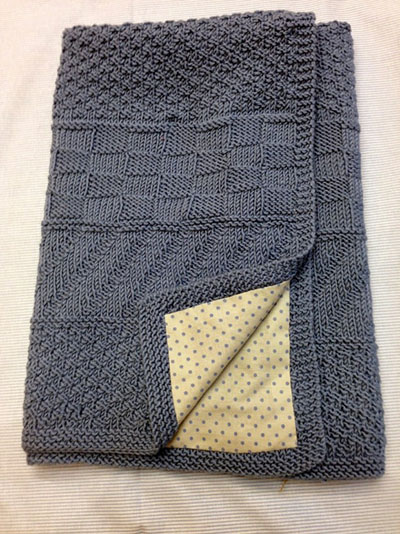
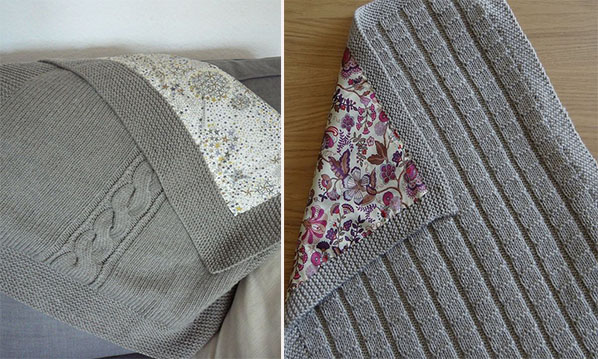
here are some tips.
For lining choose:
But for the paddyka, which the kid on the top photo took refuge in, a particularly soft merino yarn 350g and knitting needles 4.5mm was used
Approximate size 64x82 cm
The initial 128 loops, counting along with the edge loops.

Empty facial cells, cells with crosses - purlins.
If you have any questions about knitting a child's rug with needles, write in the comments.
Knit with pleasure.
With knit stylish plaid knitting is easy. If you know how to knit a scarf, it means that you can easily knit a blanket for your cozy home. There are 3 ways to knit a plaid with knitting needles. Who is more to their liking. With this question it is better to decide, so to speak, on the shore, before embarking on swimming, that is, in knitting. That the trip was pleasant, and the result is amazing.
This is a reasonable choice of tools, as the canvas is large, and to keep it all the time on weight, the prospect is not exciting.
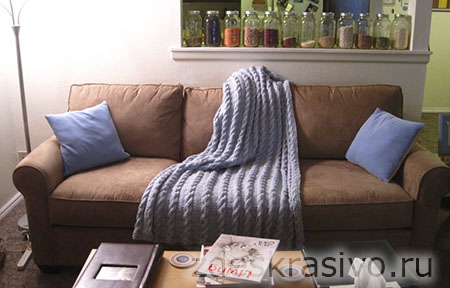 Blue plaid braids
Blue plaid braids The motif of the pattern is extremely simple, 6 loops of the front for the braid and 6 loops of the purl for the path between the braids, again 6 loops of the front, etc.
 Pattern braids
Pattern braids I love to knit braids and harnesses, it turns out quickly. How here, to lash out 4 lines, to make an interlacing of the braid, to knit 4 more rows, to make an interlacing again, you see, she has already fastened 5 centimeters. It is convenient to count, not nervously, the pattern is voluminous, the canvas is soft and beautiful.
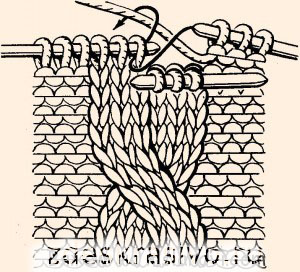 Blue Plaid Pattern
Blue Plaid Pattern  Here, already have something to warm your knees.
Here, already have something to warm your knees. That's how it looks after a couple of days, well, who, like, of course. Now it is autumn and the blanket will be ready for the winter cold, and now, in the autumn rainy days, you can cover your knees with your semipod during work. Cozy.
That's just instead of embossed braids, a pattern is chosen here. This is good because the wrong side and the person will have the same rights.
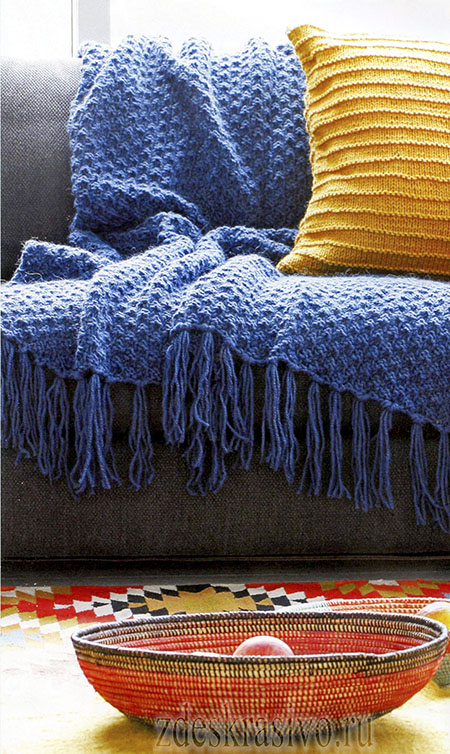 Blue plaid
Blue plaid 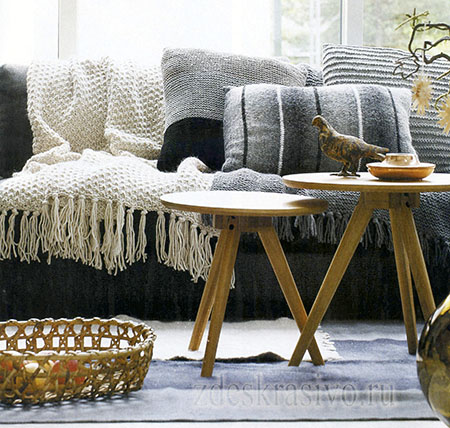 Beige plaid
Beige plaid Description of how to knit blue or beige fringed plaids:
The scheme for blue and beige rug with fringe:
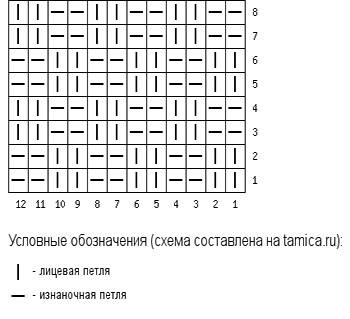
Note: It was suggested in the comments that the description of the fringed plaid has a typo in indicating the weight of the skein. I want to explain why these sizes are indicated.
Here options are offered, how to tie a plaid with knitting needles from two different types yarn. You will get such a blanket using both one yarn and another. Sly alpaca, which is present in the first version, fluffs the thread. A skein of such yarn is light and voluminous, and to the touch, like a kitten you iron. When knitting there is a feature. The thread seems to be drawn out, it is very plastic, and in the finished product it is slightly picked up and the canvas becomes more voluminous. And in the second version, there is no yarn for the alpaca plaid, but acrylic is almost 80%. Acrylic is a more organized thread, does not stretch and is not so light. This is the secret.
The magazine offering schemes for plaids, wants to show that you need to approach knitting creatively, choose what you like, read recommendations for choosing yarn and needles numbers, but check everything on patterns.
I took photos of various yarns and patterns. I can not insert a photo in the comments, so I had to do it in the article.
For example, for yarn c alpaca from Pekhorka, with a weight and length of the thread is almost like in a magazine (as part of more alpaca, and therefore fluffy more), 4 mm knitting needles are recommended. But in the reviews I see both 3mm and 4.5mm.

And photos of yarn and sample with yarn 50% wool and 50% acrylic. It was such a yarn 50 by 50 for Alena, who raised the question of a typo and asked which knitting needles to use. Question in the comments at the bottom of the article.

Only a pattern connected by you will help you understand how much yarn and which knitting needles you need for knitting a plaid.
I tied this stole for a long time, but I never used the stole myself, but as a plaid, it got accustomed to us, it’s a pity that I didn’t immediately understand how to knit wider. Although in the description it was said that this pattern will look good on a bedspread or plaid.
Even our cats cram on such a narrow product.
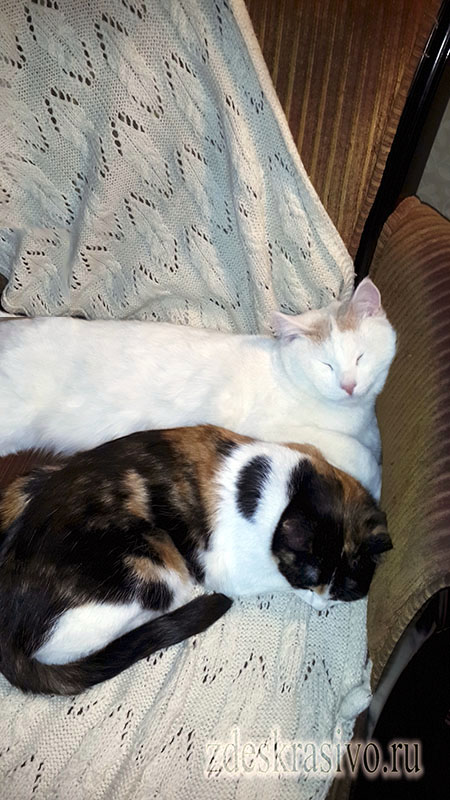 Cats on the rug
Cats on the rug Look at this pattern, it is good because its wrong side is also attractive, it is mirrored to the face, only where there is a bulge on the face, and inside is a concavity.
I attached a scheme according to which I knitted a tippet, for a rug it is not necessary to knit corners with tassels, so you can start knitting right from the 53 row, and you need to calculate how many loops you need for your plaid using the usual pattern. Dial loops 15-20 knit a pattern, close, wash, dry and count in the middle of the sample, how many loops in a centimeter. I did, because I knit not with cotton, but with wool blend yarn.
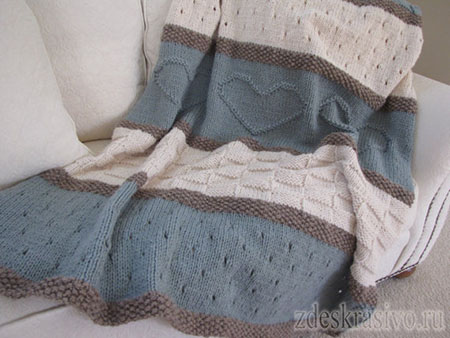 Plaid with a heart-1
Plaid with a heart-1 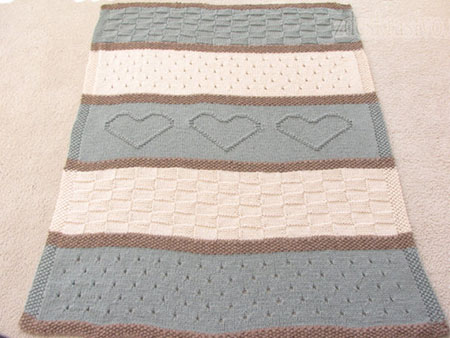 Plaid with a heart-2
Plaid with a heart-2 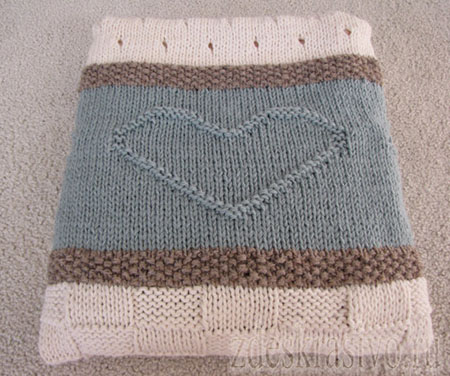 Plaid with a heart-3
Plaid with a heart-3 The knitting pattern is very clearly visible in the photos, so how to tie such a blanket:
But for the most novice beginners on the site published an article with detailed diagrams and description of the work. Please link to the article:
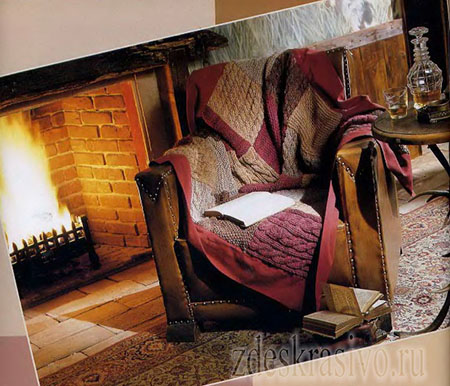 Plaid of fragments on a fabric lining
Plaid of fragments on a fabric lining 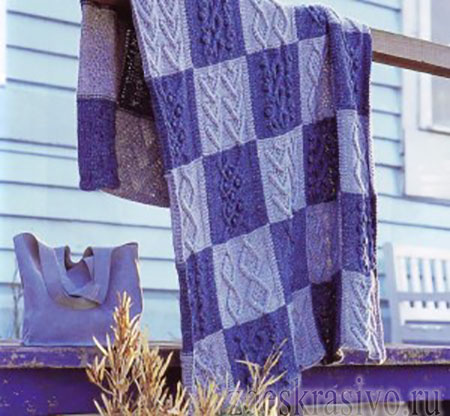 Plaid of squares in different patterns
Plaid of squares in different patterns How to knit, see the instructions:
Simple and very elegant plaid bedspread by Martha Stewart (marthastewart.com)
On such a blanket will take about 38 skeins of gray bulk yarn and 3 skeins of yellow wool yarn. It is connected with the usual garter stitch and is stitched with a thread of a contrasting color. The edge is crocheted.
 Elegant Plaid Bedspread
Elegant Plaid Bedspread 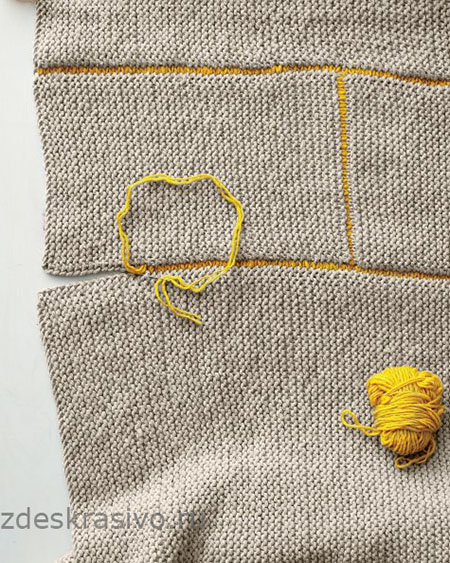 We combine the details of the plaid
We combine the details of the plaid In the video, I showed how to sew the details of the rug and how to tie the hem.
Below is a diagram of the plaid on which this luxurious plaid is connected.
 Plaid chart
Plaid chart 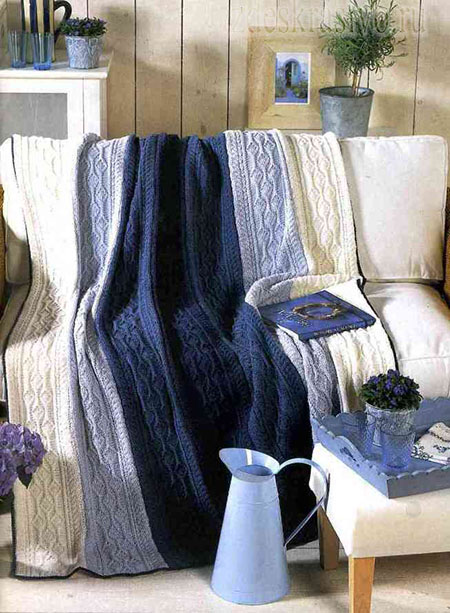 Strip Plaid
Strip Plaid 
Pleasant choice and inspiration.
| Related articles: | |
|
Heavy tongue in mouth. Burning mouth
Dry mouth - in medicine is called xerostomia, it is a symptom ... Bitcoin mining: everything you need to know for beginners
Many users experience familiarity with digital currency ... How to choose the color of varnish to clothes?
Selection of lacquer color is not a simple matter, because its shade is due not only ... | |